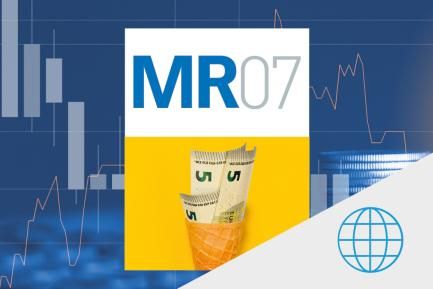
A highly uncertain global recovery

The good news is that, despite reflecting the intense impact of the extraordinary lockdown measures across practically the entire globe at the beginning of the quarter, the GDP data for Q2 has been somewhat better than expected. The bad news is that Q3 has got off to a rather shaky start. The health data for Q3 indicate that in the US and Latin America the pandemic remains very active, while in Europe, which seemed to be entering a phase of greater control, the outbreaks of recent weeks are a source of concern and new mobility restrictions cannot be ruled out. The economic indicators, meanwhile, suggest that the pace of the recovery has slowed somewhat during the course of the quarter. All of this fuels a very high level of global uncertainty. Despite this context, the CaixaBank Research scenario is broadly compatible with the latest developments: global GDP will fall on the order of 4% in 2020, and then, supported by stimulus measures and assuming that the impact of subsequent waves of the pandemic is lower than last spring,
it should recover in 2021.

ADVANCED ECONOMIES
The available figures on COVID-19 infections and deaths in the US indicate two aspects: the pandemic is still very much present in the world’s leading economy, but the curve appears to be flattening. In any case, both the infection and death rates and the risks of potential further outbreaks remain high. Despite this situation, the US health strategy in many states remains more lax than those being followed elsewhere, such as in Europe. In contrast, the fiscal and monetary measures introduced to support the economy have been among the most comprehensive of all advanced economies. In particular, we estimate that the direct-spending measures approved to date could exceed 1.7 trillion dollars (~9% of GDP), while the guarantees and other liquidity measures could exceed 1 trillion dollars (~6% of GDP). In addition, new aid proposals (worth a further 1 trillion dollars) are currently being drawn up in Congress. The Fed has also taken decisive action. In the first half of the year it cut interest rates by 150 bps, bringing them down to the 0.00%-0.25% range, it continues to conduct mass asset purchases (it is purchasing treasuries and MBSs at a rate of 80 billion dollars a month), and it is supporting firms and households through initiatives such as the Main Street Lending programme.

This combination of a more lax lockdown and strong support from economic policy helps to explain why this figure is one of the least negative among advanced economies, despite US GDP falling by 9.1% quarter-on-quarter in Q2 2020 (–31.7% quarter-on-quarter on an annualised basis, placing GDP –9% below its levels in the same quarter of the previous year), the biggest quarter-on-quarter decline since the Great Depression. By components of demand, the contraction was widespread, although private consumption registered a particularly sharp decline, having been heavily affected by the country’s severe restrictions on mobility. On the other hand, exports also registered a sharp contraction. That said, as was the case in the previous quarter, the large decline in imports led to a small positive contribution from the external demand. Similarly, public expenditure also made a positive contribution to GDP. However, both elements fell well short of offsetting the huge declines registered in other components. In the second half of the year, we expect to see a rebound in economic activity, although this improvement looks fragile and will be highly dependent on how the pandemic develops. For the time being, and although some figures registered a deceleration in the summer, the latest indicators appear to support this picture of improvement.


The EU perfectly exemplifies the aforementioned evolution at the global level. Specifically, the GDP declines in Q2 were on a scale not witnessed since the Second World War (in quarter-on-quarter terms, –12.1% for the euro area as a whole, –9.7% in Germany, –13.8% in France, –12.4% in Italy and –18.5% in Spain). Nevertheless, and despite the dismal figures, the GDP declines were somewhat smaller than expected. This marginally positive reading, however, has been overshadowed by the fact that the August PMI activity indicators clearly show that while the recovery continues, it is losing momentum as Q3 progresses.

In this context, and with the benefit of a broader time perspective, we can see that the decisions taken by the European Council at the end of July in relation to the recovery plan (called Next Generation EU) and the new multiannual financial framework (EU budget) are of critical importance. In addition to the strong signal that it sends out about Europe’s commitment to the recovery (the ECB and Member States are no longer battling alone), we welcome the fact that the new plans maintain the same total amount as envisaged in the ambitious initial proposal (750 billion euros), as well as the requirement for certain conditions
to be met and the strategy of continuing to finance the plan through the European Commission issuing bonds backed by the increase in the EU’s own resources (the EU budget).

The short-term impact of the COVID-19 outbreak is being felt simultaneously across the globe, and emerging economies are no different, although discrepancies are apparent in the toll it is taking on economic activity. In general, the degree to which these countries are currently suffering depends on whether they had macro imbalances (inflation, public deficit, private debt, etc.) prior to the current shock, as well as on their degree of exposure to the focal points of the pandemic (Europe and America, at present). This, in turn, drives how strict or lax the social distancing measures and mobility restrictions are, which is the most important factor in determining the rate of decline in economic activity and its subsequent recovery.

The slump in GDP in Q2, the period in which economies registered productive shutdowns, varies widely from country to country, ranging from the (relatively) less dramatic fall in GDP in Russia (–8.5% year-on-year) or Turkey (–9.9% year-on-year) to unprecedented setbacks in countries such as Mexico (–18.7% year-on-year) or India (–23.9% year on year). Other emerging countries, such as Brazil (–11.4% year-on-year), lie somewhere in the middle of the spectrum. With such a dramatic impact in Q2, the available data suggest a somewhat more dynamic recovery in early Q3 in countries such as Turkey, Brazil, Poland, Indonesia, India and Russia. However, it remains to be seen whether the new outbreaks of the virus in different locations recede and whether the recovery is consolidated, or, as has happened in other economies, loses strength as the quarter progresses. On the other hand, in the case of Turkey, it remains to be seen whether other sources of uncertainty besides the economic recovery itself, such as the credibility of monetary policy, cease to cast doubts and apply pressure on the currency.

The case of China can be of interest for drawing some lessons, as it was the first country to suffer the economic consequences of the COVID-19 outbreak and it is also the first to relax the lockdown measures and return to relative normality. What does its evolution tell us? Firstly, it tells us that the initial rebound when the restrictions on activity and mobility are lifted can be quite strong. Indeed, growth in Q2 2020 was notably higher than expected, reaching 11.5% quarter-on-quarter (+3.2% year-on-year). This represents a rapid and significant rebound following the collapse in economic activity in Q1 caused by the impact of the coronavirus (–10.0% quarter-on-quarter and –6.8% year-on-year). Can this behaviour be extrapolated to other emerging economies? Only in part. The recovery in domestic demand, with a sharp recovery in «pent-up demand» in sectors such as manufacturing and real estate in the case of China, is likely to occur in other countries. In contrast, the strong support from the foreign sector, which was partially driven by exports of Chinese products related to the COVID-19 outbreak, seems more idiosyncratic. As for Q3, China’s economic activity indicators suggest a slight loss of momentum in the recovery.



